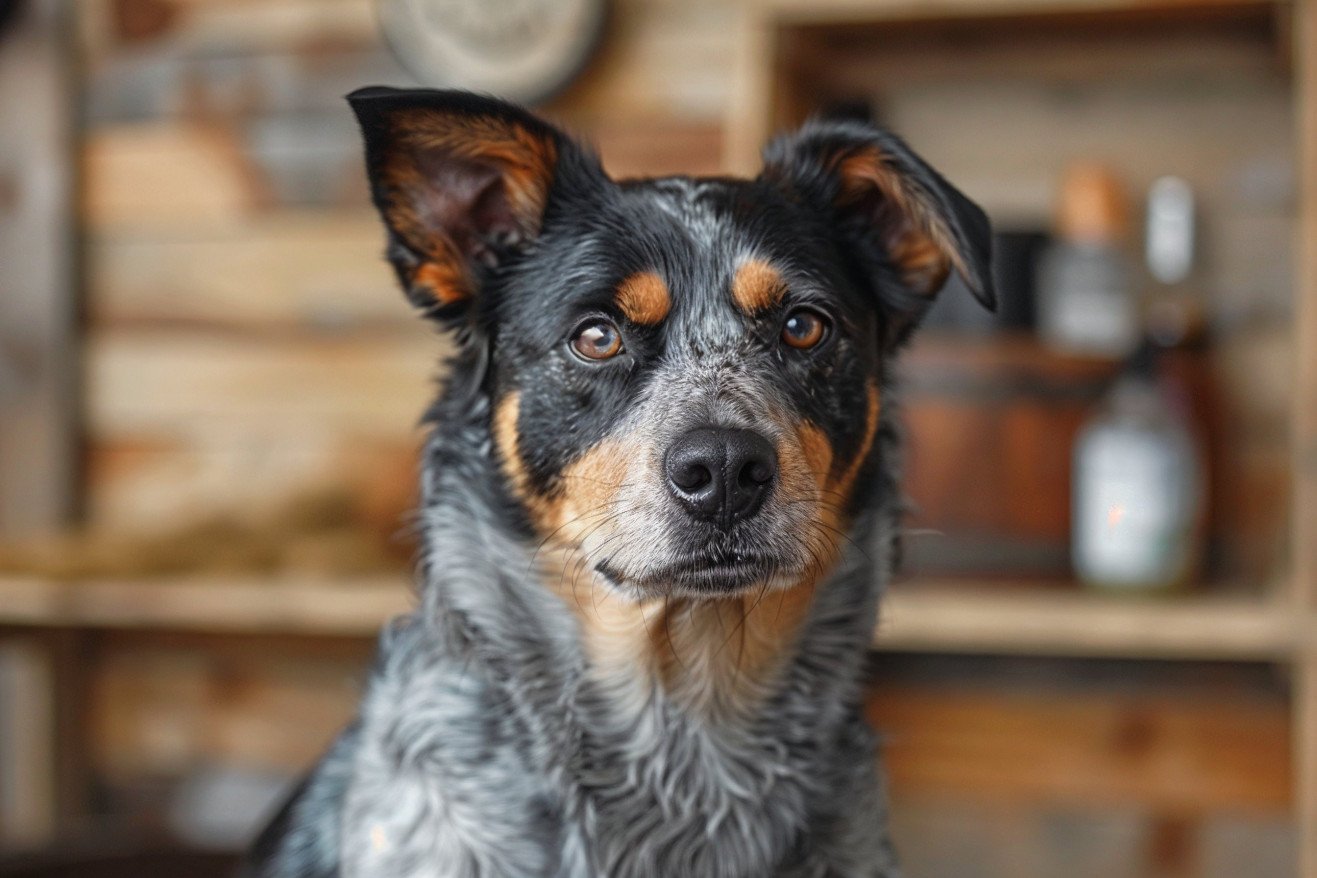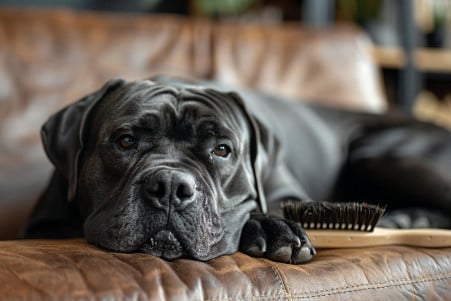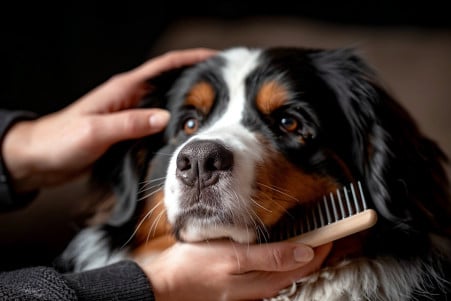Do Blue Heelers Shed? Understanding Australian Cattle Dog Shedding Patterns
12 March 2024 • Updated 11 March 2024

If you’re thinking about adopting a Blue Heeler, you may be wondering about their shedding patterns. Blue Heelers, also known as Australian Cattle Dogs, have a double coat that sheds moderately throughout the year and blows twice a year, typically in the spring and fall. Regular brushing can help keep shedding under control.
This article will review animal science research, insights from veterinarians, and information from seasoned dog breeders to provide a complete picture of Blue Heelers’ shedding tendencies.
We’ll cover everything from the biological processes that drive shedding to the role of diet and health to the best grooming practices to keep your Blue Heeler’s coat healthy and your home free from excessive fur. This in-depth look will offer tips for keeping shedding in check and a realistic view of what to expect from this lively breed.
Do Blue Heelers shed?
What Blue Heelers’ Shedding Is Like
Blue Heelers have a double coat, which consists of a soft undercoat and a coarser outer coat. This double coat helps them regulate their body temperature and protects them from the elements, which is important for a working breed that spends a lot of time outdoors.
While Blue Heelers shed year-round, they also have a blow coat twice a year. This occurs in the spring and fall when they shed their undercoat in clumps to help them adjust to the changing weather.
The intensity of a Blue Heeler’s shedding can be influenced by a number of factors. For example, the climate can play a role in how much a Blue Heeler sheds. DogsPlanet explains that dogs in warmer climates will shed more than those in cooler climates.
A dog’s overall health can also impact their shedding. If a dog is sick, they may shed more or less than normal. Finally, a dog’s genetics will also impact how much they shed. Some Blue Heelers will shed more than others.
It’s important for all Blue Heeler owners to be aware of these shedding patterns. This knowledge will help them appreciate the role that grooming and health play in managing their dog’s shedding.
Understanding the Shedding: Diet, Health, and Genetics
There are many different factors that go into a dog’s shedding, and this is especially true for Blue Heelers. From diet to health to genetics, there are many things that can impact how much a Blue Heeler sheds, and none of them are random.
According to WebMD, one of the most important things that can impact a dog’s shedding is the quality of their diet. If a dog is getting the right nutrients, it can help their coat and reduce shedding.
A good diet can help to make sure that a dog’s hair follicles are strong and healthy, and that their skin is well-hydrated, all of which can help to reduce shedding.
Health problems can also have a big impact on how much a dog sheds. PetMD says that things like allergies, skin infections, or hormonal imbalances can all lead to a dog shedding more than they should. This is why it’s so important to make sure that a dog is going to the vet regularly. This is also important because it can help to make sure that a dog’s shedding is healthy.
In addition to this, BetterVet says that genetics play a big role in how much a dog sheds. Just like some breeds are more prone to shedding because of their history and coat type, Blue Heelers have genetic traits that can help to predict how much they’ll shed.
By making sure that a Blue Heeler’s diet and health are in good shape, pet parents can impact how much their dog sheds and the quality of their coat. As we continue to learn more about this breed, we’re also learning that grooming is an important part of making sure that their double coat is healthy.
Grooming Your Blue Heeler
Because of their double coat, which is made up of a short, dense undercoat and a longer, coarser outer coat, Blue Heelers need to be groomed in a way that will help keep their shedding under control. Espree recommends a basic grooming schedule for the breed that includes occasional baths and regular brushing. The undercoat is short and dense and can become matted if it’s not brushed, especially during the breed’s biannual blow coat.
It’s important to make sure you have the right tools. Wag suggests using an undercoat rake and a slicker brush to remove loose fur and prevent matting. Weekly grooming with these tools should be enough, but you may need to brush your dog more often during the blow coat to keep the shedding in check.
While professional grooming will provide a more comprehensive level of care, there are many benefits to grooming your Blue Heeler at home, including the chance to bond with your pet and save money.
Vetstreet recommends weekly brushing and occasional baths to keep their hard, flat coats clean and healthy. No matter which option you choose, make sure you’re grooming your Blue Heeler regularly so you can keep an eye on their coat and how their shedding changes over time.
Shedding and Health: How to Care for Your Blue Heeler’s Coat
The health of your Blue Heeler’s coat is a direct reflection of their overall health. As a VCA Animal Hospitals article explains, a glossy, smooth coat and healthy skin are good signs that your dog is in good health.
If your Blue Heeler is shedding more than usual or if there are changes in the way their coat looks, it could be a sign of an underlying health issue. Changes in the shedding cycle can be a sign of stress, nutritional deficiencies, or skin issues like dermatitis or infections.
To keep your Blue Heeler’s coat healthy, it’s important to make sure they’re getting a well-balanced diet that includes plenty of high-quality proteins, fats, and vitamins. Keep an eye out for signs of a problem, such as a lackluster coat, increased shedding, or skin issues. Regular grooming is also important for maintaining the health of their skin and coat since it helps remove dead hair and distributes natural oils.
If you notice any sudden changes in your dog’s shedding or coat quality, make sure to take them to the vet right away. By keeping an eye on these elements of your Blue Heeler’s health, you can help control their shedding and make sure they stay as healthy and active as their personality.
Genetics of Blue Heeler Shedding
Much like a long-term relationship, the answer to why Blue Heelers shed is complicated and involves genetics. A study in Animal Genetics looks at the genetics of coat color and other associated traits, including shedding.
While coat color is determined by a complex interplay of genes, there are also specific genetic markers that determine how much a dog will shed. According to Hollywood Feed University, the MC5R and RSPO2 genes are the most important when it comes to dog shedding.
The MC5R gene is expressed in hair follicles and has a variant that is linked to hair shedding. This means that the expression of this gene can be used to determine how much a Blue Heeler will shed. This can help researchers and dog owners better understand the grooming needs of Blue Heelers.
Meanwhile, a study in the Public Library of Science found that the RSPO2, FGF5, and KRT71 genes are the most important when it comes to determining coat length in dogs, which impacts how much a dog sheds.
This means that breeders and Blue Heeler owners can use an understanding of these genetic factors to determine how much a dog is likely to shed and select for certain traits. This can be especially important when it comes to breeding, as selecting parents with the right shedding traits can help ensure that future generations of Blue Heelers will have coats that are easier to manage.
The Acceptance of the Shed: A Blue Heeler Owner’s Manual to Shedding
In summary, Blue Heelers are a special breed with a unique shedding schedule that is impacted by their double coat. However, regular grooming can help you stay on top of their moderate year-round shedding and their biannual “blow coat” and both are completely normal. Shedding can also be impacted by diet, health, climate, and genetics, and will vary from dog to dog.
That said, the most important thing to remember is that a healthy Blue Heeler coat is a well-groomed one, and it’s important to stay on top of your dog’s health. A good diet, which is also important for nutrition, may help reduce shedding. Regular vet check-ups and paying close attention to your dog’s health is important, especially if they are dealing with allergies or skin issues, which can cause more shedding.
Knowing these things about shedding and taking steps to stay ahead of them is part of being a good dog owner. By accepting the grooming and care that Blue Heelers need, you can make shedding a more manageable part of your life.
In the end, while shedding may be a big part of the Blue Heeler, it doesn’t detract from their fun-loving personality and loyalty. With the right information and care, shedding can be just one more aspect of the incredible experience of having a Blue Heeler in your life.


